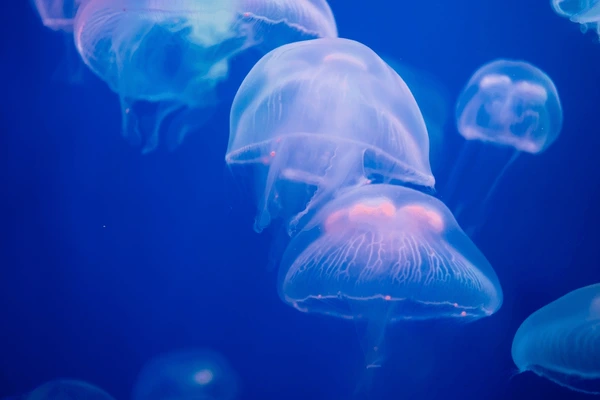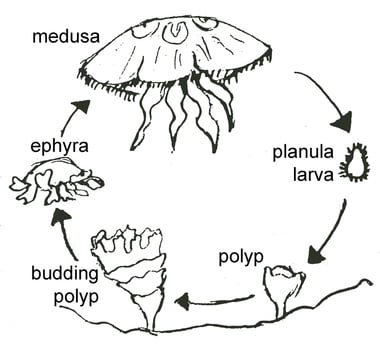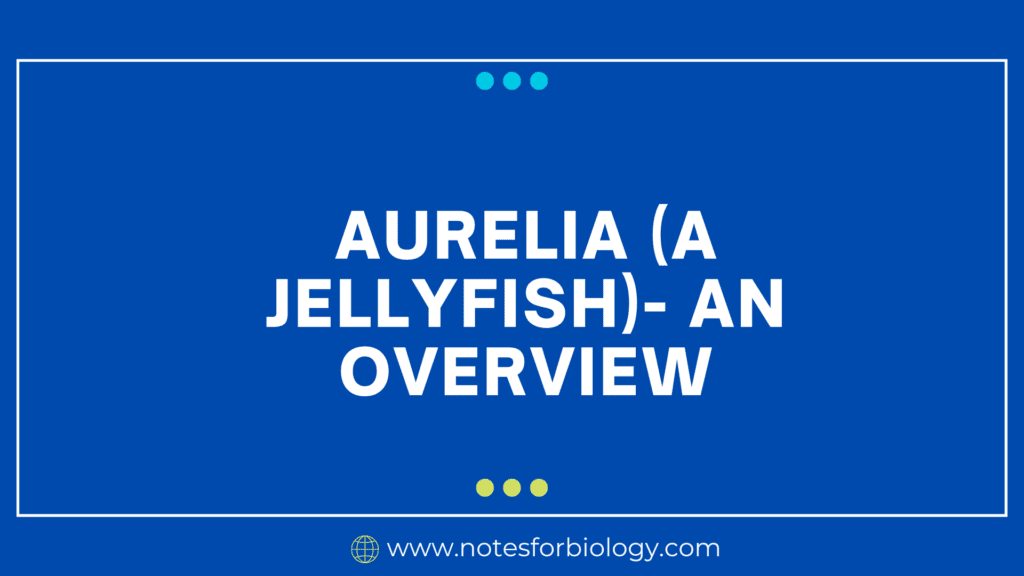Aurelia is a genus of scyphozoan jellyfish, commonly known as moon jellyfish because of its unique characteristics and extensive range of distribution, the genus Aurelia, generally recognized as the moon jellyfish, is a scyphozoan jellyfish. Coastal seas all over the world are home to members of this genus. There are multiple species in the genus, the most well-known of which is Aurelia aurita. These jellyfish are distinguished by their bell-shaped bodies, which frequently have a diameter of up to 40 centimeters, and their translucent, gelatinous bodies. Generally found in coastal areas across the globe, they are distinguished by their distinct life cycle consisting of both sexual and asexual reproduction stages.
Table of Contents
Aurelia

Key Characteristics of Aurelia
Appearance
- Bell with an umbrella-like transparency.
- Tiny, delicate tentacles encircling the bell’s edge.
- Visible through the bell, gonads frequently take the shape of a four-leaf clover.
- usually light in hue, with shades ranging from pink or light blue to milky white.
Habitat
- Found in temperate and tropical coastal waters.
- Commonly inhabit bays, harbors, and estuaries.
Commonly inhabit bays, harbors, and estuaries.
Oceans all around the world are home to this species, which are mostly found in tropical and temperate seas. Their preferred habitat is the coast, where they frequently gather in bays, ports, and estuaries with warm, nutrient-rich water.
Life Cycle
The life cycle of jellyfish includes both sexual and asexual reproduction stages

- Planula: A free-swimming planula larva starts the life cycle. It settles on a substrate and grows into a polyp.
- Polyp: The polyp stage is a sessile phase in which budding is the means of asexual reproduction for the organism.
- Ephyra: The polyp eventually divides into multiple ephyra (young jellyfish) through a process known as strobilation.
- Medusa: The adult, free-swimming jellyfish with the ability to reproduce sexually is developed from the ephyra stage.
Feeding and Diet
- Commonly inhabit bays, harbors, and estuaries.
- Fish larvae, tiny crustaceans, and phytoplankton are among the small planktonic creatures that it mainly consumes. They catch prey with their tentacles, and cilia along the oral arms carry the captured food to the mouth.
Ecological Role
Predator: They are important in regulating the numbers of their prey species since they are predators.
Prey: Larger marine animals like as sea turtles, specific fish species, and seagulls eat them as well.
Bloom Formation: When conditions are right, it can produce enormous blooms that can disrupt nearby marine ecosystems by driving out other species in search of food and habitat.
Human Interaction
Aquarium Display: Moon jellyfish are frequently housed in public aquariums for decorative and educational purposes because to their intriguing appearance.
Study: Aurelia is widely investigated in biological and environmental research, offering valuable insights into neuroscience, developmental biology, and the consequences of climate change on marine organisms.
Economic Impact: Jellyfish blooms may have detrimental effects on the local economy by blocking fishing nets, chilling power plant intakes, and reducing tourism in coastal areas.
Conservation Status
Although Aurelia species are not currently listed as endangered, environmental factors including pollution, climate change, and habitat destruction have an impact on their populations. To maintain the stability of jellyfish populations and the diversity of marine life overall, conservation efforts are concentrated on protecting marine ecosystems and cutting down on pollution. Aurelia, often referred to as the moon jellyfish because of its translucent, disc-shaped body, is a fascinating marine creature
Frequently Asked Questions(FAQ)
Define Aurelia?
Aurelia is a genus of scyphozoan jellyfish, commonly known as moon jellyfish because of its unique characteristics and extensive range of distribution, the genus Aurelia, generally recognized as the moon jellyfish, is a scyphozoan jellyfish.
Are Aurelia jellyfish poisonous?
The moon jelly poses minimal threat to humans, despite being well-known for their capacity to sting. They do this by forcing a toxin into their target by harpoon-like cells on their tentacles.
Why is Aurelia called jellyfish?
Because of its jelly-like shape and fish-like floating behavior, it is known as the “jelly fish.”
Is Aurelia jellyfish polyp or Medusa?
Aurelia aurita polyps undergo a progressive subdivision process that results in the transformation of many medusae (jellyfish).
Related Article

